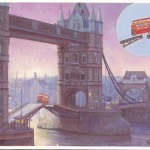In 1991, at the 24 Hours of Le Mans the Mazda 787B from the team Mazdaspeed, entered history by becoming the first Japanese-built car to win the race. This race was historic in two ways; this was the first and only victory for a Japanese car manufacturer, and the first and only victory for a car powered by a Wankel rotary engine. The engine is normally rated as 2622cc but the FIA rated the car as a 4708cc by dimension of having two power cycles per rotation. The engine produced around 700 hp.
Mazdaspeed started race with three cars and one spare. One of them was Mazda 787 that had a debut in 1990. with the number 56. Another two were brand new Mazda 787Bs, numbered 18 and 55. Number 18 was driven by David Kennedy, Stefan Johansson and Maurizio Sandro-Sala, number 56’s crew were Takashi Yorino, Yojiro Terada and Pierre Dieudonné, and in the number 55 drivers were Volker Weidler, Johnny Herbert and Bertrand Gachot (this was his only appearance and his only race). The spare car was another 787 from the previous year but this car didn’t take part in this race.

At the start of the race, three Mazda’s 787B had 19th (#55), 23rd (#18) and 30th (#56) starting positions. It’s interesting to mention that the actual positions won during qualifications were 12th, 17th and 24th. This was because all new 3.5 litre cars were moved to the first grid positions moving everyone else back by seven places.
During the race the Mazda drivers had a very specific lap time to run with the goal to complete the calculated 367 laps without running out of fuel.
The day before the race, team manager Ohashi decided to drop his usual conservative strategy and instructed the drivers of the #55 car to drive as if it were a short sprint race.
The decision was made based on the reliability of the cars demonstrated in the previous tests, as well as the car’s exceptional fuel economy.
In the early stages of the race, the #55 car made its way to third place with the #18 car behind it 2 laps down. The #18 had a lower gear ratio setup meaning the car used less fuel but was 20 km/h (12 mph) slower. The Mazda 787B #55 came on to second position after the Mercedes-Benz C11 of Michael Schumacher, Fritz Kreutzpointner and Karl Wendlinger spun off and later pitted with a gearbox problem.
At the 22nd hour, fate took a hand and the #55 turned out to be the faster of the two 787Bs and it was running second when the leading Sauber was forced into the pit for a prolonged stop due to mechanical problems. At the last pit-stop, Herbert asked to stay in the car, and drove the 787B across the finish line first. The #55 car led the 1991 24 Hours of Le Mans from lap 320 to the finish, claiming the win. The flawless performance resulted in the historic victory. The two other 787Bs finished sixth (#18) and eighth (#56).
Herbert was so dehydrated after the race that he had to be assisted out of the car and taken to the circuit’s medical center. As a result, he was unable to make it to the podium, leaving Weidler and Gatchot to take up the celebrations. The winning car ran without a hitch apart from a blown headlamp bulb and a precautionary rear wheel bearing change on the driver’s side of the car, when a regular check during a pit stop showed it to be overheating slightly.
In this historic race the Mazda 787B completed 362 laps and 3,059.79 miles (4923.200 km) with the average speed of 127.49 mph (205.133 km/h).
The Le Mans winning Mazda 787B was returned to Japan and disassembled in front of the gathered media. Close inspection of the parts suggested that the car could have run for another 24 hours without problems. A third 787B was built to replace the Le Mans winner in the remaining rounds of the championship. These ‘sprint’ races did not particularly suit the Mazda and no notable results were scored.
At the end of the racing season in 1991, Wankel rotary engines were outlawed and, as per FIA’s earlier decision, 3.5-litre Formula One engines became the standard for the 1992 season. The following year, Mazda entered the MXR-01, based on the Jaguar XJR-14 and powered by a Judd unit, without much success (placed 4th at Le Mans 1992).
Technical data for Mazda 787B
Body
- Body construction: Kevlar/carbon fiber
- Wheels: 18 in x 12 in front/18 in x 14.75 in rear Volk Racing Magnesium Alloy (17 in x 12 in front/17 in x 14.75 in rear)
- Brakes: Carbon Industries outboard ventilated 14-inch (360 mm) carbon discs and calipers (Brembo steel)
- Weight: c. 850 kg
Engine
- Configuration: R26B R4
- Location: Mid, longitudinally mounted
- Displacement: 2.616 liter
- Rotors: 4
- Spark plugs: 3 per rotor
- Fuel feed: Nippon Denso electronic fuel injection
- Aspiration: Naturally Aspirated
- Power: 700 hp / 522 KW @ 9000 rpm
- Torque: 608 Nm / 448 ft lbs @ 6500 rpm
Sources:
http://en.wikipedia.org/wiki/Mazda_787b
http://www.mazda.com.au/community/news/2011/5/mazda-787b-1991-winning-car-returns-to-le-mans-after-20-years










